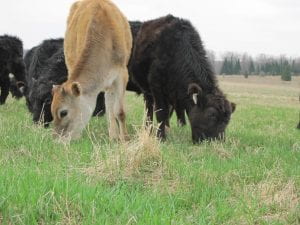We seem to be getting an early spring this year. As I write this at the end of April, my average grass height in the pasture is almost 5”. The fences have all been checked and the water system is up and running. In fact, I have had my sheep out on pasture for about two weeks already (but not just pasture).
So, let’s review the decision making process for making the decision to transitioning your cattle, sheep, or goats to pasture. We need to think about it both from the perspective of the plants and the perspective of the livestock.
Let’s start with the livestock. They are going to transition from a stored feed that may be relatively dry and is high in effective fiber to a lush young grass shoot that is as high as 85% water, very high in protein, and is very highly digestible with little effective fiber. If the transition is made to quickly, your animals will have very watery manure and will likely lose weight as their rumens struggle to make the change. So the key is to make the transition slowly over the course of 10 days to 2 weeks. In my case, I am providing supplemental hay on pasture within a very limited pasture area. With each passing day, I give them another small area of pasture. This allows my animals to adjust to the change in diet while I start managing my pasture system for the coming year.
Now the plant’s perspective. Remember, in spring the plants are at their lowest energy reserves and are using those reserves to build their ‘solar panel’. Grazing these plants before they have developed a full set of “grazing panels” can weaken the plant and typically reduces the total amount of dry matter production on those fields for the current year. However, one of the greatest challenges of waiting until the grass is 8”-10” tall before starting grazing is that all of your pasture is then at the same stage of production and setting up a rotational system is more challenging. So, by starting ‘early’ in a specific area of the pasture helps to develop what is called the grazing wedge. A grazing wedge refers to having your pasture subdivisions or paddocks at varying stages of re-growth. Just make sure that you don’t come back to these ‘first grazed’ paddocks until the plants have fully recovered. Also, switch up where you start your spring grazing every year to avoid permanently setting back the productivity of that paddock.
So, in order to have a safe transition for both the plants and the grazing livestock, it is best to make the transition over the period of a few weeks. Here are some techniques commonly used in this area to make the transition:
- Set aside some pasture the previous fall to be used as spring stockpile. In addition to having some fibrous dry matter from the previous season available to the animals, the plants in these pastures will have been able to build larger energy reserves for the winter months and will actually green up faster in the spring.
- Continue to have highly palatable yet higher in fiber dry hay available to the animals as they are first turned out on pasture. Mid-summer second or third cut hay is often higher in fiber and yet still very palatable. Your livestock may not appear to eat much of it, but they will eat enough to maintain their rumen mat.
- Find a way to limit the time on pasture. Start by letting them out of the barn for only a few hours a day, build to leaving them out for half days, and ultimately for the entire day. Make sure you have appropriate quality hay still available to them in the barn or lot.
- Feed a high energy/low protein concentrate. Remember that the early spring grass has a lot of protein – more than the animal actually needs. If there is sufficient energy in the diet, the rumen bugs can capture this protein where it can be used as energy further down the digestive tract. If energy is lacking, this protein ends up in the bloodstream as ammonia and ends up in the liver where it is converted to urea. This takes energy, which the animal often may pull from their fat stores. This is why some growing animals appear to lose weight as they are turned out to pasture.
The 2020 grazing season is off to a great start. With thoughtful management, your animals will benefit from the spring flush and your pastures will be set up for a good year of grazing!


